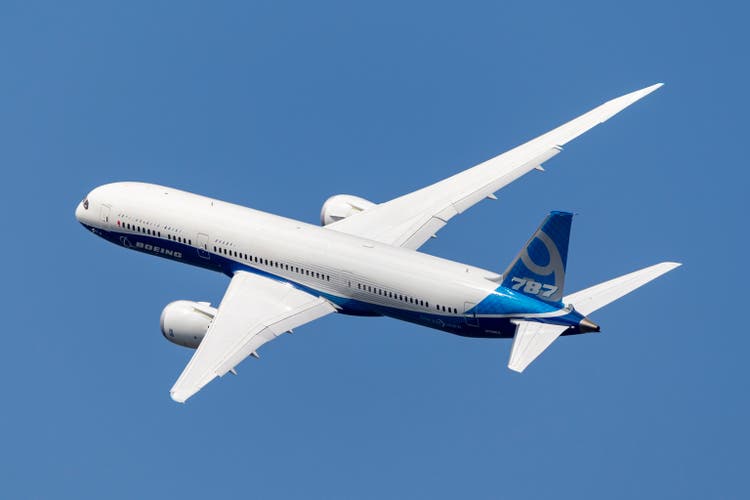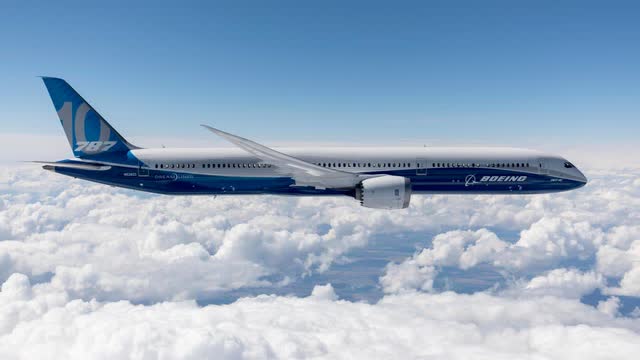Ryan Fletcher
For Boeing (NYSE:BA), the past years have all been about absorbing bad news and waiting for good news which often came in slower than investors were comfortable with. Slowly but surely we do see that things are improving for Boeing. Debt levels have not shown satisfying reduction in the quarter and delivery numbers might be lower than expected for the year but that does not discount the fact that things are improving in a tough environment for aerospace companies. I believe that that could provide a nice entry point for investors as waiting for results to reflect the improvement might mean that you are missing some appreciation in share prices. The most recent development that makes Boeing stock somewhat more likeable is that the FAA has approved Boeing’s inspection and rework plan paving the way for delivery resumption on the Boeing 787 program.
When Will Boeing 787 Deliveries Resume?
The most recent development in Boeing’s that the FAA has approved Boeing’s plan to inspect and rework the Boeing 787. In the aftermath of the Boeing 737 MAX crashes Boeing intensified scrutiny and so did the aviation administration, which led to abnormal production and delivery volumes for nearly two years. In March 2021, Boeing did deliver some aircraft but deliveries were halted again as the FAA had not approved Boeing’s inspection plan. Over the course of the delivery stop, the design of the Boeing 787 has been thoroughly reviewed by both Boeing and the FAA while Boeing dove deeper into the supply chain to assure quality.
In April, Boeing shared that it had submitted its inspection and rework plan to the FAA but not much later it became clear that Boeing had filed the plan shortly before reporting quarterly earnings and the FAA deemed the plan incomplete giving the impression that Boeing submitted the plan in order to have some sort of update for investors during the earnings call. With the plan approved, Boeing is not going to deliver the bulk of its stockpiled Dreamliners at once. There will be a ramp up in deliveries, but that ramp up trajectory or delivery start has not been shared by Boeing. However, we do get some insights if we look at some schedules communicated by airlines. United Airlines (UAL) expects no more than five Dreamliner deliveries this year with no indication of the date for the first delivery.
American Airlines (AAL) provided more insights as it shared that it expected nine deliveries in the third quarter and the first two would deliver in August. So, if everything goes according to plan Boeing 787 deliveries will resume in August 2022. What should be kept in mind is that Boeing is currently producing conforming aircraft, so that should help get the delivery flow going but delivering from the production line does not help reducing the stockpile and the FAA retains the capacity to sign off on aircraft clearing them for delivery so that could potentially cause delays as well.
Boeing 787 Delivery Resumption Drives Balance Sheet Health Improvement and Cash Flow
As some of you might know, I have been following Boeing’s commercial aircraft programs for years as part of my aerospace coverage. One thing I have reiterated various times is how investors could be missing share price appreciation if they wait for improvement to be reflected in Boeing’s metrics and the positive developments on the Dreamliner program are just another example of that. Since I published the report on the positives and realities of the Boeing 787 delivery resumption Boeing stock value increased by 24% compared to 10% for the broader markets. So, believe it or not… Boeing outperformed the market significantly.
I was planning on updating my assessment on the Boeing 787 stockpile and its value to the company using the company’s most recent numbers. However, during my previous assessment I already made decisions such as the number of aircraft in inventory that now are shown to be correct. As a result, I will not redo the math for which I refer you to my previous investor report. Instead I think it is important to acknowledge that with the assessment proven to be accurate, investors who would have used the June report would have benefited more than investors who are a bit late to the party and respond to headlines. Deep dive and data driven assessment as provided by The Aerospace Forum enables more juice rewards for investors.
The reality of the pool of produced Dreamliner aircraft is that it represents around $35 billion in value measured by list price, which no customer ever pays and up to $17.6 billion in revenues. On cash level, the 120 Dreamliners represent $7 billion in delivery payments. However, there is about $3.5 billion in customer compensations leaving $3.5 billion of those PDPs and there also are abnormal production costs in the amount of $937 million that need to be expenses. Assuming that these are all cash items that would leave around $2.5 billion as cash contributions without any outstanding supplier payment. If we incorporate all abnormal costs and expense them against the PDP balance it would get us to a net contribution of up to $500 million. That means that the value of the deliveries is big but on cash level it might be significantly smaller although I do expect that the $3.5 billion in customer compensation is not all in cash form. Overall, from current levels I would expect cash contributions of around $2.5 billion from the current levels which Boeing can use to reduce its enormous debt pile. On unit level this would mean Boeing would receive just $20.8 million on net basis significantly lower than the normal business flow would suggest but this is still accretive to Boeing’s cash levels.
Boeing has warned for variability in the initial deliveries as customer compensations are being renders so we won’t see the full effect of the delivery resumption immediately. However, what should be kept in mind is that Boeing is producing conforming aircraft on which cash margins will be strong and Boeing should have capacity in its system to step up those rates to 5 aircraft per month which will improve the total revenues, cash flows in total as well as cost improvement on unit basis.
Conclusion: Boeing Is Becoming More Attractive
While Boeing certainly does face its fair share of challenges going forward, I believe that with the Boeing 787 delivery resumption imminent and the Boeing 737 MAX production and delivery flow improving I can now mark Boeing as a buy as I believe that these commercial aircraft programs combined offer further upside to share prices and will drive cash flow and balance sheet recovery.



Be the first to comment